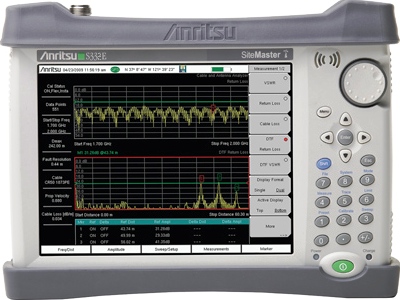
|
|
The Anritsu S332E Site Master integrated cable and antenna analyzer and spectrum analyzer dramatically enhances your productivity and transforms the traditional fix-after-failure maintenance model to one that allows you to identify and address minor problems before they become major ones. 4.5 hour battery operation time. Store 2000 Traces internally. Cable and Antenna Analyzer Measurements: RL, VSWR, Cable Loss, DTF, Phase. Spectrum and Interference Analyzer Measurements: Occupied Bandwidth, Channel Power, ACPR, C/I. Cable and Antenna Analyzer Specifications. Frequency Range: 2 MHz to 4 GHz. Frequency Accuracy: <= ± 2.5 ppm @ 25 C. Frequency Resolution: 1 kHz (RF immunity low), 100 kHz (RF immunity high). Output Power High: 0 dBm, typical. Output Power Low: –30 dBm, typical. Interference Immunity: On-Channel +17 dBm @ > 1.0 MHz from carrier frequency. Measurement Speed Return Loss: <= 1.00 ms/data point, RF immunity low, typical. Measurement Speed Distance-to-Fault: <= 1.25 ms/data point, RF immunity low, typical. Return Loss Measurement Range: 0 dB to 60 dB. VSWR Measurement Range: 1:1 to 65:1. Cable Loss Measurement Range: 0 dB to 30 dB. Distance-to-Fault Vertical Range Return Loss: 0 dB to 60 dB. Measurement Accuracy Corrected Directivity: > 42 dB, OSL Calibration. Spectrum Analyzer Specifications. Frequency Range: 9 kHz to 4 GHz. Tuning Resolution: 1 Hz. Frequency Span: 10 Hz to 4 GHz including zero span. Sweep Time: Minimum 100 ms, 10 µs to 600 s in zero span. Resolution Bandwidth (RBW): 10 Hz to 3 MHz in 1–3 sequence ± 10% (1 MHz max in zero-span) (–3 dB bandwidth). Video Bandwidth (VBW): 1 Hz to 3 MHz in 1–3 sequence (–3 dB bandwidth) (auto or manually selectable). Amplitude Dynamic Range: > 95 dB (2.4 GHz), 2/3 (TOI-DANL) in 10 Hz RBW. Amplitude Measurement Range: DANL to +26 dBm. Options. -0021, 2-Port Transmission Measurement. -0010, Bias-Tee. -0031, GPS Receiver (requires Antenna). -0019, High-Accuracy Power Meter (requires External Power Sensor). -0029, Power Meter. -0025, Interference Analyzer (recommend Option 0031). -0027, Channel Scanner. -0431, Coverage Mapping (requires Option 0031). -0090, Gated Sweep. -0028, C/W Signal Generator (requires CW Signal Generator Kit, P/N 69793). -0509, AM/FM/PM Analyzer. -0411, Ethernet Connectivity.
|